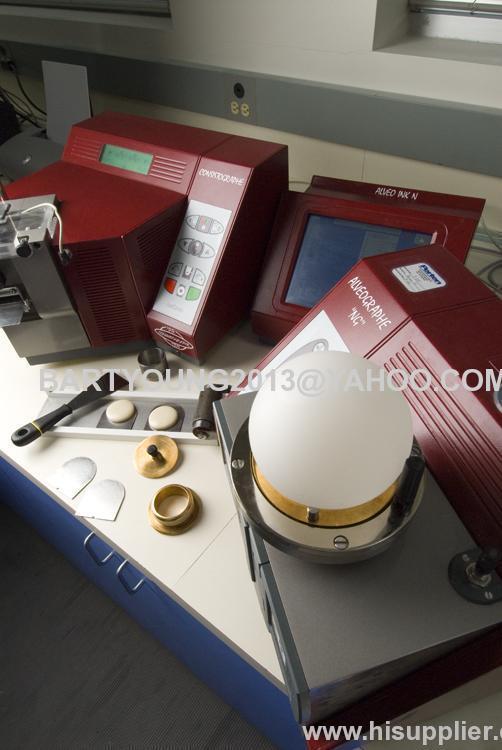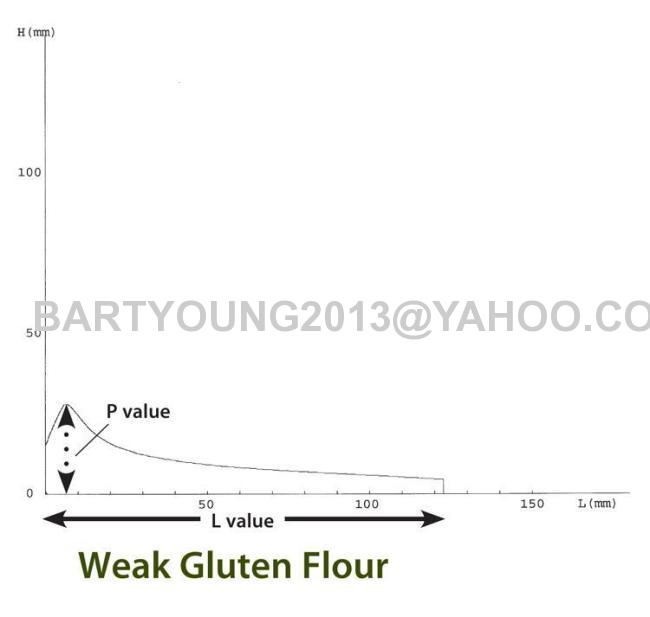
Method
1. A sample of 250 grams of flour is mixed with a salt solution to form a dough.
2. Five 4.5 centimeter circular dough patties are formed and then rested in the alveograph in a temperature-regulated compartment at 25 degrees Celsius for approximately 20 minutes.
3. Each dough patty is tested individually. The alveograph blows air into a dough patty, which expands into a bubble that eventually breaks.
4. The pressure inside the bubble is recorded as a curve on graph paper.
Results
• The alveograph determines the gluten strength of a dough by measuring the force required to blow and break a bubble of dough.
• The results include P Value, L Value, and W Value.
• A stronger dough requires more force to blow and break the bubble (higher P value).
• A bigger bubble means the dough can stretch to a very thin membrane before breaking.
• A bigger bubble indicates the dough has higher extensibility; that is, its ability to stretch before breaking (L value).
• A bigger bubble requires more force and will have a greater area under the curve (W value).
• Alveograph curves are described on page 50.
Why is this important?
The alveograph test provides results that are common specifications used by flour millers and processors to ensure a more consistent process and product. The alveograph is well suited for measuring the dough characteristics of weak gluten wheats. Weak gluten flour with low P value (strength of gluten) and long L value (extensibility) is preferred for cakes and other confectionery products. Strong gluten flour will have high P values and is preferred for breads.
The alveograph test measures and records the force required to blow and break a bubble of dough.
• P Value is the force required to blow the bubble of dough. It is indicated by the maximum height of the curve and is expressed in millimeters (mm).
• L Value is the extensibility of the dough before the bubble breaks. It is indicated by the length of the curve and is expressed in millimeters (mm).
• P/L Ratio is the balance between dough strength and
extensibility.
• W Value is the area under the curve. It is a combination of dough strength (P value) and extensibility (L value) and is expressed in joules.
Weak gluten flour has lower P values than strong gluten flour.
Adapted from Method 54-30A, Approved Methods of the American Association of Cereal Chemists, 10th Edition. 2000. St. Paul, MN.


1. A sample of 250 grams of flour is mixed with a salt solution to form a dough.
2. Five 4.5 centimeter circular dough patties are formed and then rested in the alveograph in a temperature-regulated compartment at 25 degrees Celsius for approximately 20 minutes.
3. Each dough patty is tested individually. The alveograph blows air into a dough patty, which expands into a bubble that eventually breaks.
4. The pressure inside the bubble is recorded as a curve on graph paper.
Results
• The alveograph determines the gluten strength of a dough by measuring the force required to blow and break a bubble of dough.
• The results include P Value, L Value, and W Value.
• A stronger dough requires more force to blow and break the bubble (higher P value).
• A bigger bubble means the dough can stretch to a very thin membrane before breaking.
• A bigger bubble indicates the dough has higher extensibility; that is, its ability to stretch before breaking (L value).
• A bigger bubble requires more force and will have a greater area under the curve (W value).
• Alveograph curves are described on page 50.
Why is this important?
The alveograph test provides results that are common specifications used by flour millers and processors to ensure a more consistent process and product. The alveograph is well suited for measuring the dough characteristics of weak gluten wheats. Weak gluten flour with low P value (strength of gluten) and long L value (extensibility) is preferred for cakes and other confectionery products. Strong gluten flour will have high P values and is preferred for breads.
The alveograph test measures and records the force required to blow and break a bubble of dough.
• P Value is the force required to blow the bubble of dough. It is indicated by the maximum height of the curve and is expressed in millimeters (mm).
• L Value is the extensibility of the dough before the bubble breaks. It is indicated by the length of the curve and is expressed in millimeters (mm).
• P/L Ratio is the balance between dough strength and
extensibility.
• W Value is the area under the curve. It is a combination of dough strength (P value) and extensibility (L value) and is expressed in joules.
Weak gluten flour has lower P values than strong gluten flour.
Adapted from Method 54-30A, Approved Methods of the American Association of Cereal Chemists, 10th Edition. 2000. St. Paul, MN.

